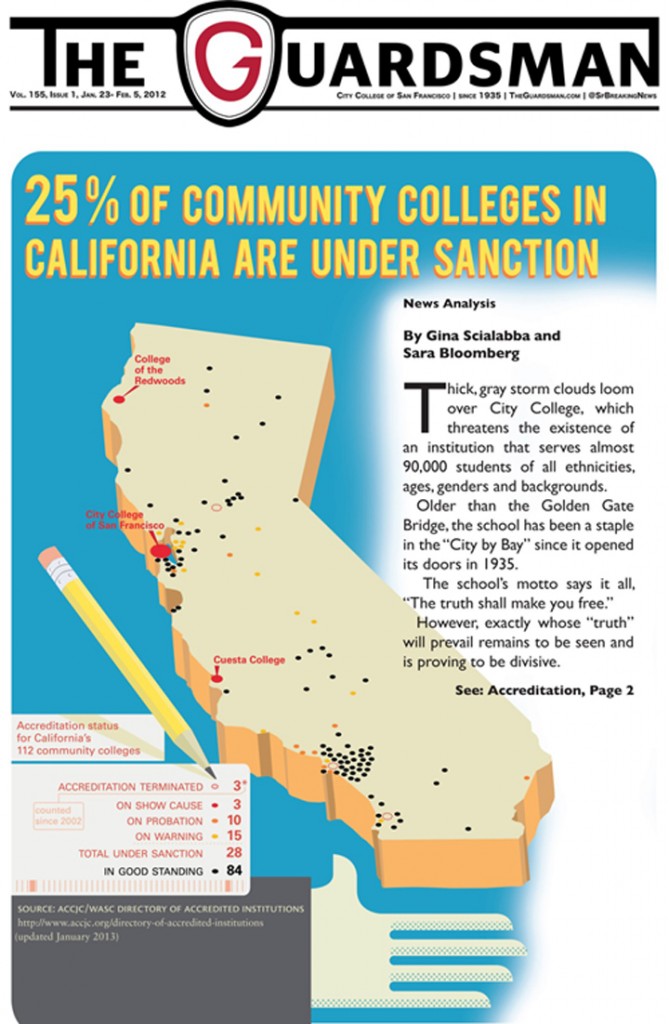News Analysis: One quarter of all community colleges in Calif. are under sanction

News Analysis
By Gina Scialabba and Sara Bloomberg
The Guardsman
Thick, gray storm clouds loom over City College, which threatens the existence of an institution that serves almost 90,000 students of all ethnicities, ages, genders and backgrounds.
Older than the Golden Gate Bridge, the school has been a staple in the “City by Bay” since it opened its doors in 1935.
The school’s motto says it all, “The truth shall make you free.”
However, exactly whose “truth” will prevail remains to be seen and is proving to be divisive.
Just three days before spring semester began, around 200 faculty and students protested against unilateral salary cuts and layoffs being imposed by the administration.
“They say this is about helping students but they’re cutting counselors,” Associated Students President Shanell Williams said at the rally on Jan. 11. “This [accreditation business] is a scam.”
Williams then led the crowd in chanting, “Sí se puede,” or “Yes we can” in Spanish.
The Accrediting Commission for Community and Junior Colleges released a report in July threatening the ultimate sanction of closure unless City College addresses 14 explicit recommendations.
The college must “show cause” why it should remain open. This “show cause report” is due this spring and the commission will render a decision in July.
The commission specifically criticized the school for spending higher than average levels on salaries and benefits for all employees—92 percent of their general budget to be exact, while other community colleges in the Bay Area have figures in the low to mid 80s.
Benefits for part-time faculty—including so-called “freeway fliers” who work for more than one community college in the Bay Area but don’t rack up enough hours at any single school to be considered full-time—are being questioned.
“We have part-time faculty who have been with the college three decades or more,” AFT Local 2121 President Alisa Messer said in an interview last semester. “To say those faculty are now not deserving of benefits strikes me as wrongheaded.”
The Board voted to dismantle a long-standing system of faculty leadership by sending department chairs back to the classroom and consolidating departments.
The move is supposed to save the school $2 million annually, as well as streamline governance. Deans will take their place. Department chairs earn annual stipends of $3,000 to $19,000 depending on the size of their departments, records show.
Faculty aren’t happy.
Leslie Simon, former chair of the Women’s Studies Department, calls it “a devastation and disintegration of democracy.”
Latin American and Latino Studies Chair Edgar Torres is concerned diversity departments will “eventually die” under this new plan and many of his colleagues share his concern.
“The attack on the diversity departments is the first step,” African American Studies chair Tarik Farrar said at a recent board meeting. “When you cut back salaries and cut benefits, you turn out cheap products!”
Labeled as austerity measures, more than 50 of the school’s 61 faculty-elected department chairs will be eliminated, while new deans are hired from out of house.
College officials insist diversity courses are not in jeopardy. It is about practical resource management.
“The department chair structure is costly, more costly than it needs to be and it is not as effective as it ought to be. It is not about eliminating departments,” said Larry Kamer, a former spokesperson hired by the college in May of 2012. “About a third of these departments have three or fewer full-time faculty, yet all have department chairs.”
Torres disagrees. He is reminded that diversity studies came about during 1970’s in response to student demand. A population with a “profound historical wound” whose voice was not being heard.
“If you are really concerned about enrollment management and increasing productivity, then you should be following the trends of demographics of the state, particularly the Bay Area. We should not be going the opposite way,” he said.
The Pew Research Center recently indicated that immigrants arriving since 2005 and their descendents will account for 82% of U.S. population growth by 2050.
Shouldn’t the classes we offer reflect that? Let’s preserve our rich diversity, not find creative ways to abolish it.
Measure A, passed by voters last November, will provide the college with $16 million a year for seven years.
Gov. Jerry Brown’s proposed budget for the 2013-2014 fiscal year allocates $376 million to the community college system. City College will receive a portion of that funding.
The college’s reserve funds are steadily climbing back up to a safe level.
With these funding sources, the school should be taken off of “show cause” and bumped up to a less severe sanction so that we can all get back to our primary mission: education.

Comments are closed.